 |
|
Ketchikan - Mile 645 |
|
 |
||||||||||||||||||||||||||
Visitor to child: "How long has it been raining?" Child: "I don't know: I'm only five.." "Southeast Alaska: The closest you can come to actually living underwater." - Ray Troll
Don’t be fooled by the restaurants and jewelry boutiques along the waterfront here; until relatively recently, this was a full on rough and tumble logging and commercial fishing town. Right where the cruise ships now tie up used to be a big sawmill and a three story smoky sawdust burner, and canneries, cold storages, and fish processors lined the waterfront. Fishing boats, headed up to Alaska from the lower 48, and bound for other parts of the remote Alaska coast would always stop here to let the crew wet their whistles. And the next morning the skipper would just hope that they all made it back aboard. Saturday nights in those days were particularly rough. Out in the channel floatplanes would start to land, big twin-engine Grumman Geese, and the slow, lumbering Stinsons, bringing in loggers from Prince of Wales Island and Tsimshian Indians from the village of Metlakatla. Then the fishing boats - big seiners and tenders - would start to arrive from the outer districts, the crews with a few bucks in their ass pockets, ready for a big night, drinking and carousing at Dolly Arthur’s and the other brothels along the boardwalk at Creek Street, known as the only place in Alaska where the fish and the fishermen both came to spawn. The first whites arrived in the 1870 to salt salmon. |
||||||||||||||||||||||||||
Ketchikan, 2011 - the big boys pretty much dominate downtown when they tie up. The big cruise ship boom started just when the town's biggest employer, the pulp mill, closed down in 1986, so it was mighty welcome, even if most of the jobs are seasonal. |
||||||||||||||||||||||||||
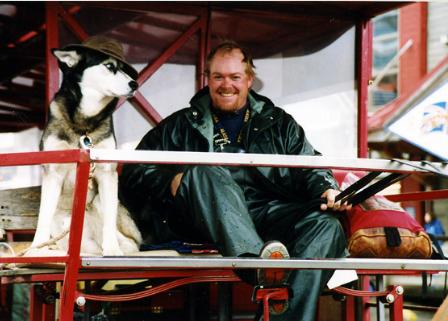 |
||||||||||||||||||||||||||
The docks are pretty much where the action is when the ships are in. If your ship tells you the excursion you want is full, chances here you might be able to find the same excursion on the dock. |
||||||||||||||||||||||||||
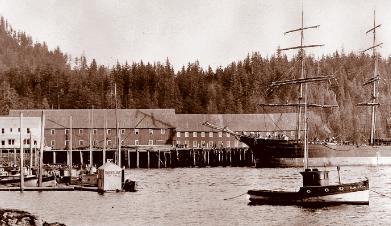 |
||||||||||||||||||||||||||
Exploring Ketchikan The good thing about all the major towns in Southeast Alaska is that they’re small and the ships usually tie up or lighter passengers ashore right in downtown. In Ketchikan, there’s plenty to see on foot within a few blocks of the ship, and lots of variety if you want to walk a little further, as well as regular city buses if your feet get too tired to walk back! The big Southeast Alaska Discovery Center downtown has excellent historical exhibits, a bookstore, coffee shop, and theatre showing a free regular feature on native culture. Adjacent is The Great Alaska Lumberjack Show, highlighting loggers competing in axe work, tree climbing, etc. Another block or so of walking takes you to Creek St., the old red light district, today transformed into one of the more unique and eclectic shopping and eating areas of Alaska. The creek was handy - in prohibition days, bootleggers would slink up in the black of the night at high tide, paddle under the establishments, give the secret knock, and trapdoors would open and eager hands change cash for booze. A short walk to the north is the Tongass Historical Society, and to the east the Totem Heritage Center. On the left just before the bridge over the creek is an excellent bookstore, Parnassus. |
||||||||||||||||||||||||||
Loring, 20 miles north of Ketchikan was typical of canneries built all over Alaska - red painted buildings on pilings out over the water. In the early days square riggers like this one would leave San Francisco full of building, canning, and fishing supplies, including boats and crews. They would sail to a likely spot, unload, and the crews would build the whole cannery, launch the boats, can the fish and then at the end of the season, send all the canned fish along with the cannery and fishing crews back to California, leaving just a caretaker. And all this before FedEx and the internet! Tongass Historical Society photo. |
||||||||||||||||||||||||||
Next, as the technology to put fish in cans was developed, the first of many canneries were established, and Ketchikan became a primary fishing center. The history of Ketchikan is deeply intertwined with the three major native tribes of the region, the Tlingits, Haidas, and Tsimshians. Natives traditionally fished commercially and worked in the canneries as well as the sawmills. When the whites arrived, there were numerous native villages throughout the area, but over time some of these settlements were depopulated primarily because of the diseases that the first whites brought to the area. Big industry came to town around 1950, in the shape of the big Ketchikan Pulp Company mill out at Wards Cove, eight miles north of downtown. Conceived as a way to utilize some of the vast spruce and hemlock forests of the region, and generate good paying, year round jobs (most fish and fish processing jobs were seasonal) the mill got a sweet deal from the U.S. Forest Service, and quickly became the largest employer in town. But by the 1960s and 70s, salmon fishermen began to complain that logging practices like driving bulldozers down the middle of salmon streams and indiscriminate clear cutting was reducing the salmon runs on which they depended. The mill operators wanted to cut when and how they pleased, were backed up by the Forest Service, and for years there was ill feeling between these two factions in town. Eventually more responsible logging practices reduced the timber available to harvest and much to the surprise of its employees, the mill closed its doors in 1997. Today, a smaller plywood mill operates on Gravina Island, but employs just a fraction of what the big Louisiana Pacific owned mill did. |
||||||||||||||||||||||||||
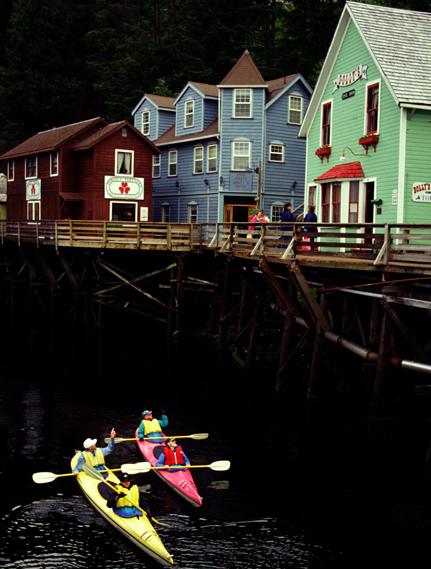 |
||||||||||||||||||||||||||
Creek St. is just a short walk from the cruise docks and has a wide variety of shops and places to eat. It is Ketchikan's old red light district and the joke was that it was one of the few places where both the fish and the men came to spawn. |
||||||||||||||||||||||||||
A really nice two mile walk, one way, is along the waterfront to the south past cannery row and the Coast Guard Station to Saxman, a native village with an excellent collection of totem poles, a clan lodge with the Cape Fox Dancers performing when the ships are in, as well as a carving shed. Of the three totem pole collections around Ketchikan, I like Saxman the best, because it is in an actual native village, and one gets a true sense of the struggle to make it in a fishing and logging economy. Also the walk along the shore is a great place to look for bald eagles and see how many of the waterfront places have a plane in their backyard. There is a city bus that stops at the bottom of the hill - schedule and fare posted inside the little tribal museum on the right just up the hill - if you want to rest your feet on the way back. If you are up for a longer walk, consider the trip up to Deer Mountain Trail, entrance near Creek St. Back in town a good place to catch some lunch is the Westmark Cape Fox Lodge - take the tramway that operates from Creek Street. On a bluff just south of downtown, the dining room offers a dramatic vista of the busy waterways and islands in front of town. At sea level just south of Creek St, is the unpretentious New York Hotel and Cafe, looking out on the boat harbor and the cruise ships beyond. Most of the galleries and gift shops are located between the tunnel on Front Street, and Creek St. If you walk along the waterfront to the north past the tunnel, you’ll find plenty of authentic Alaska to look at, especially along the water side. Take some time to look around at the boats in the small boat harbors on both sides of the downtown docks where the cruise ships tie up. On most of the US coasts, boats this size - 40’ and under - would be mostly be used for day fishing, the crews returning home at night to sleep in their own beds. But in Alaska with the fishing grounds often many hours from the nearest town, these boats are homes for their crews - often couples, sometimes with young children, for months at a time. While tourism dominates the central part of town, there are canneries and cold storage facilities along the waterfront both north and south of downtown. Salmon and to a lesser extent, halibut are the dominant species harvested by local fishermen. |
||||||||||||||||||||||||||
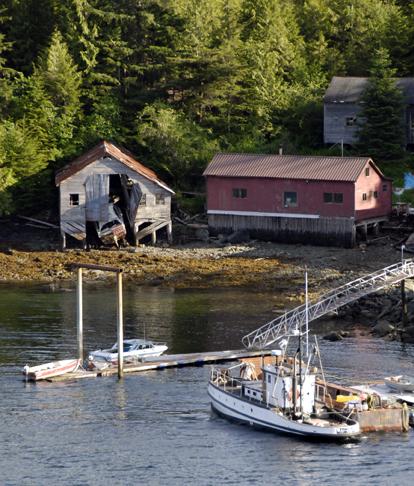 |
||||||||||||||||||||||||||
The other Alaska - have a look off to the opposite side of your ship as you enter Ketchikan - this is roadless Pennock Island, with numerous waterfront homesteads - definately the old Alaska! |
||||||||||||||||||||||||||
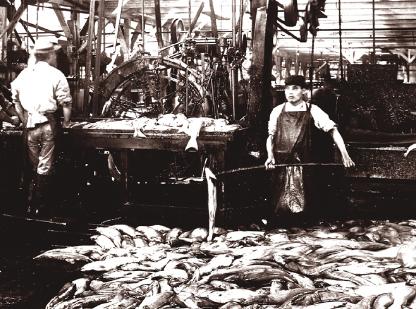 |
||||||||||||||||||||||||||
Chinese cannery workers were a key part of the work force, and they would often have their own kitchens, mess halls, and bunkhouses. |
||||||||||||||||||||||||||